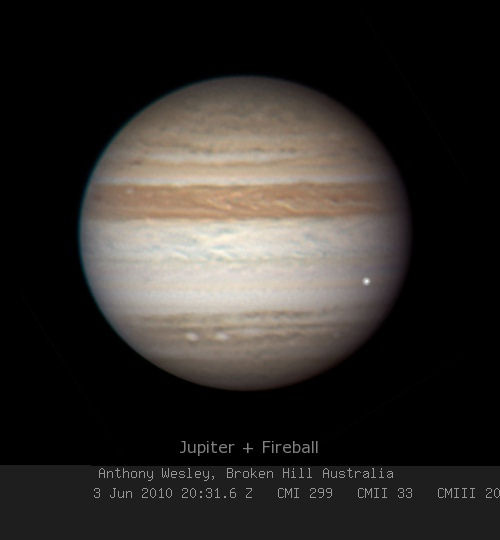Astronomers Perplexed by Jupiter Collisions

The huge, burning object thatslammed into Jupiter last week still remains a mystery to scientists who arecurrently examining this latest impact on the gas giant.
The newest Jupitercollision was spotted Friday by amateur astronomers Anthony Wesley inAustralia and Christopher Go in the Philippines. It occurred less than a yearafter another object whacked Jupiter last summer.
Wesley posted photos of theblazing fireball that signaled the collision to his website. They were takenfrom Broken Hill, Australia. [Video of the Jupiter fireball.]
Scientists are now analyzing theimpact, in hopes of being able to identify the cosmic object that crashed intothe largest planet in our solar system.
For the time being, however,there is no consensus on what it was, said Heidi Hammel of the Space ScienceInstitute in Boulder, Colo.
Hammel was the lead researcher ofa study that was recently published in The Astrophysical Journal Letters, whichdetermined that a rogueasteroid about 1,600 feet (500 meters) was the culprit in anotherspectacular crash on Jupiter that occurred on July 19, 2009.
It was Wesley, too, who firstspotted the July 2009 Jupitercrash. His observations kicked off an international observation campaign tostudy the impact site.
Get the Space.com Newsletter
Breaking space news, the latest updates on rocket launches, skywatching events and more!
Studies about Jupiter's latestimpact are already underway, though no results have been released so far.
"We are working on the dataanalysis and I cannot say news on this," Agustin Sanchez-Lavega of theUniversity of the Basque Country in Bilbao, Spain, told SPACE.com in an e-mail.
With this new collision comingless than a year after the July 2009 incident, researchers are rethinking currentestimates of the frequency of such planetary impacts on Jupiter.
"Certainly the impactprobability statistics seem to need revision, based on these two events withinthe past 11 months," Hammel told SPACE.com.
Jupiter is certainly no strangerto violent impacts. In 1994, the cometShoemaker-Levy 9 broke into more than 20 pieces and pelted the gasgiant repeatedly. At the time, astronomers estimated such impacts could occuron Jupiter every 50 to 250 years.
- Photos- Rogue Asteroid Hits Jupiter
- BigFireball on Jupiter Spotted by Amateur Astronomers
- Video- Fireball on Jupiter: Asteroid Hits Gas Giant
Join our Space Forums to keep talking space on the latest missions, night sky and more! And if you have a news tip, correction or comment, let us know at: community@space.com.

Denise Chow is a former Space.com staff writer who then worked as assistant managing editor at Live Science before moving to NBC News as a science reporter, where she focuses on general science and climate change. She spent two years with Space.com, writing about rocket launches and covering NASA's final three space shuttle missions, before joining the Live Science team in 2013. A Canadian transplant, Denise has a bachelor's degree from the University of Toronto, and a master's degree in journalism from New York University. At NBC News, Denise covers general science and climate change.









